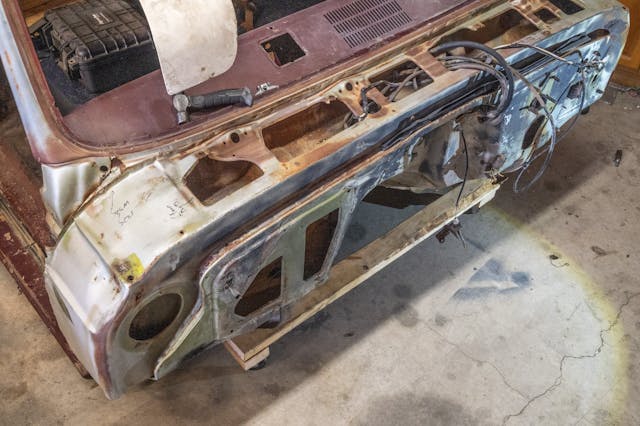Media | Articles
Wrenchin’ Wednesday: Roller jig for a long-term bodywork project

Some portions of a project can’t be finished in a weekend, and they often can’t sit in the middle of your workspace 24/7 either. In a previous installment of Wrenchin’ Wednesday, we built a simple tool for lifting truck cabs with an engine hoist. It’s incredibly handy for lifting the cab on and off a frame, or out of a trailer in my case, but for working in the garage it’s a little cumbersome to have to roll the hoist out, unfold it, and get it set up. Plus, setting the cab up on blocks or jack stands can make it feel like working in a loosely nailed-down treehouse that’s ready to topple down, not the ideal situation when hammering out dents.
The cab needs bodywork and, as anyone who ever dives into the land of dent repair and body filler would know, it’s a long process of chasing perfection. I needed to build a simple jig for rolling it around my shop floor when I’ve got time to work on it — a big secret to finishing projects is to make it convenient to work on them.
Everyone’s individual build will be unique to the body they intend to support, and where its pick-up points and reinforcements are placed, but I’ll walk you through what considerations came into my particular jig. First, the 67-72 GM C/K pickup cab has four mounting points with two stamped steel rails running fore and aft, parallel to the frame rails, to support the seats and other major anchor points inside the cab. The easy move was to build a frame that’d support the cab on these rails, so I measured the lengths of the rails, along with the widths between those rails at the front and rear of the cab, as they splayed out slightly.
Some recycled casters from a broken furniture dolly worked perfectly in combination with 3-inch wood screws, and the assembly came together quickly once the overall dimensions were sorted out. Of course, the loose boards were mocked up against the cab before being screwed together, ensuring that the crucial moment when the cab’s full weight would rest on it wouldn’t end up in disaster.
The big plus is that the cab is nice and low to the ground, which will make the work around the rain gutter and other areas a little less backbreaking too. Eventually, I’ll need to get this cab up higher to work on some of that rust underneath, and this platform can be easily modified to elevate the cab up higher down the road — maybe in another installment?
Marketplace
Buy and sell classics with confidence




















